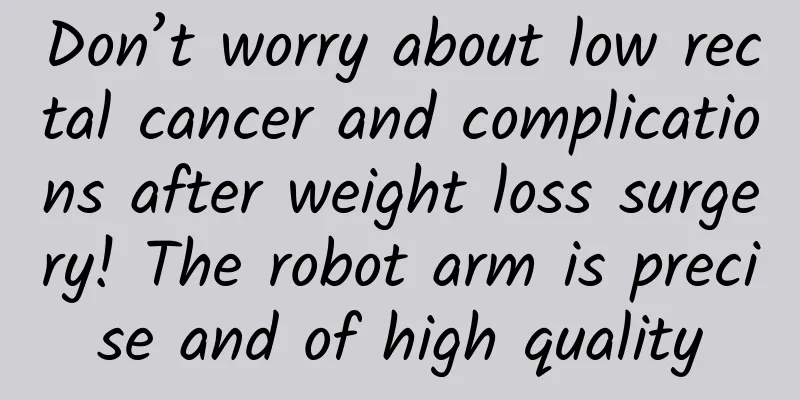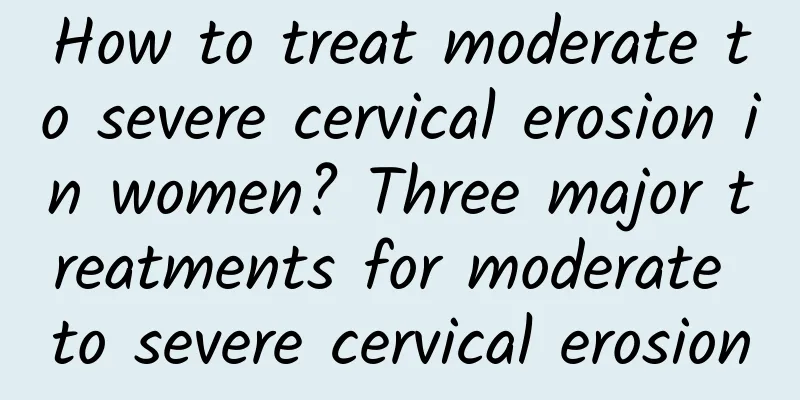Don’t worry about low rectal cancer and complications after weight loss surgery! The robot arm is precise and of high quality

|
Is it possible to eliminate the shortage of surgeons and allow surgeons to return in large numbers? Surgery often encounters some difficult and complicated cases, among which the surgery for low rectal cancer in colorectal cancer must avoid inadvertent rupture of tumor tissue due to traditional surgery, or complications caused by failed weight loss surgery, which requires corrective weight loss surgery. When faced with these two difficult problems, Da Vinci robotic surgery can now be used to overcome the shortcomings of traditional surgery, providing a new surgical option that is high-quality, precise, time-saving, has fewer complications, and has a good prognosis. It can even increase the willingness of young doctors to choose surgery! A 43-year-old unmarried patient with rectal cancer sought folk remedies because he was worried that he would need an artificial anus for surgery, which might also affect his sexual function. Later, because the tumor grew so large that it blocked his anus and he could no longer defecate, he realized that his condition was serious and he needed to see a doctor. After oncologists first perform local radiotherapy and chemotherapy to achieve the goals of tumor shrinkage and lowering the preoperative stage of the cancer, the patient is then transferred to surgery for evaluation in the hope of a radical treatment. Dr. Zheng Yihe, a general surgeon at Shin Kong Hospital, said that the use of the Da Vinci procedure to treat rectal cancer improves surgical precision. Da Vinci surgery for low rectal cancer eliminates the need for artificial anus and has a good prognosis Dr. Zheng Yihe from the General Surgery Department of Shin Kong Hospital said that after evaluation, the patient's tumor was less than 5 centimeters away from the anus, which was a low rectal cancer. After observing the tumor stage after initial chemotherapy, it was recommended that the patient could use the Da Vinci surgery. Although laparoscopic surgery can be performed when the tumor is less than 5 cm away from the anus, a temporary artificial anus is often required to allow the surgical sutures to be repaired for 3 months to 6 months. On the other hand, patients are worried that the surgery may accidentally damage nerves and affect their future sexual function, so they are unwilling to have an artificial anus, which delays the treatment time. The da Vinci surgery for rectal cancer improves surgical precision, and the field of view is 3D. In a narrow space, the nerves can be seen clearly, without worrying about affecting sexual function or urinary nerves. In addition, the instrument is highly flexible and has a 270-degree operating angle. Even if tissue adhesion occurs or the surgery enters deep into the pelvic cavity, the tumor will not be damaged. Most cases do not require an artificial anus after the operation. Although the operation time may be longer than laparoscopic surgery due to the arm setting procedure, the patient suffers less pain after the operation and can return to normal life after a week of rest. Da Vinci surgery has the advantages of minimally invasive surgery and a wide field of vision. The following situations include: the tumor is located in a low position, the patient has received electrotherapy, the surgical site is expected to be inaccessible to laparoscopic instruments, or the instruments cannot be bent and suture reconstruction is necessary. The robotic arm can accomplish the task. Traditional surgery involves inserting a hand into a large wound, while laparoscopic surgery is like inserting a chopstick into a small wound. The Da Vinci surgery is a combination of the two, combining the advantages of both traditional and laparoscopic surgeries while improving their disadvantages. The focus is on improving the quality of surgery. The intestinal reconstruction sutures are precise and meticulous, and the quality of life after surgery is also better. Da Vinci robotic arm surgery breaks through the shortcomings of traditional surgery and provides a new surgical option that is high-quality, precise, time-saving, has fewer complications, and has good prognosis. Da Vinci helps patients undergoing bariatric surgery maintain a healthy weight In addition to its good results in the treatment of rectal cancer, Da Vinci is also very effective in corrective weight loss surgery. Dr. Fang Yuelin, a general surgeon at Shin Kong Hospital, said that in recent years, the concept of minimally invasive surgery has been incorporated into weight loss surgery. With the increasing number of obese or type 2 diabetic patients in China, more and more patients are willing or must undergo weight loss metabolic surgery. Some patients who have failed traditional surgeries in the past, developed complications after surgery, had poor weight loss results, or gained weight again, need to undergo surgery again to help solve the problem, or seek better surgical methods for correction. Therefore, the necessity of corrective weight loss surgery has begun to emerge. However, if the correction is performed by traditional laparotomy or laparoscopic surgery, the first thing the surgeon has to deal with is tissue adhesion. The second is the poor condition of the affected tissue. The third is that multiple intestinal resections and anastomosis reconstructions must be performed. All of these test the surgeon's skills, patience and experience. The robotic arm can rotate at an angle and cover a range that even exceeds that of the doctor's hands. It can perform delicate and dexterous clean treatment on sticky and difficult-to-separate tissues and organs, demonstrating excellent suturing and reconstruction performance. It is an excellent tool for secondary or multiple weight loss correction surgeries. A 48-year-old patient's weight soared to more than 170 kilograms 7 or 8 years ago. He had undergone a certain weight loss surgery (gastric septum and bypass surgery) in his hospital. Afterwards, he developed a complication of gastric outlet stenosis, which affected his appetite for many years and even caused him to vomit after eating. Due to the sequelae, he became morbidly thin and weighed only 100 kilograms. After consultation at Shin Kong Hospital, a detailed imaging evaluation and gastrointestinal endoscopy were performed, and after full communication, the patient was recommended to undergo robotic arm corrective weight loss surgery. The reconstructive surgery was to change the gastric bypass surgery performed by the previous doctor into a standard gastric bypass surgery. Postoperatively, the patient has gone from only being able to eat liquid food to soft food in just a few weeks, and has slowly returned to a healthy weight of 70 to 80 kg. He is currently recovering well and his diet remains healthy. Dr. Fang Yuelin, a general surgeon at Shin Kong Hospital, said that the robotic arm can rotate at an angle and cover a range that even exceeds that of a doctor's hands, making it an excellent tool for performing secondary or multiple weight loss correction surgeries. The new generation of da Vinci surgical arms are smaller and more flexible, improving prognosis Dr. Fang Yuelin said that corrective weight loss surgery requires consideration of multiple intestinal anastomosis reconstructions and severe tissue adhesions, which can be said to be quite complex and challenging. Shin Kong Hospital has introduced the Da Vinci robotic arm and has performed over 500 surgeries, with patients responding well to the treatments. In the past, open surgery was painful for doctors, and laparoscopic surgery was tiring. However, the use of robotic arms has increased doctors' willingness to perform difficult, delicate, or complex surgeries. Especially after training with the Da Vinci, this accumulated experience can improve laparoscopic surgery technology and make up for the shortcomings of laparoscopy, which has been performed for 30 years. More importantly, it will help increase the willingness of young doctors to choose surgery in the foreseeable future, which will also be a great blessing for patients! |
Recommend
Why do I only have my period once every two months?
Why do I only have my period once every two month...
What to eat after miscarriage? What are the recommended diets after miscarriage?
Abortion is very harmful to women's bodies. I...
Chinese yam and goose meat soup can be used for dietary therapy of patients after abortion
Yam and goose meat soup can replenish qi and stre...
What are the harmful manifestations of various vaginitis?
Vaginitis, as the name implies, refers to a disea...
How does TCM diagnose vulvar leukoplakia?
The diagnosis of vulvar leukoplakia in traditiona...
How to implement a low GI diet? Tips for choosing meals when dining out
Eating out of the home is another challenge you f...
You can lose weight by taking a bath and brushing your teeth! Seize the spare time to exercise and lose weight faster
Make good use of the short time for washing and b...
What are the clinical symptoms of cervicitis? 4 tips to teach you how to effectively prevent cervicitis
Cervicitis is a common gynecological disease for ...
No wonder you can’t lose weight! Check the food you eat to see if it contains a lot of refined sugar and trans fat.
In addition to being obesogenic, processed foods ...
What are the methods for detecting endometrial tuberculosis?
There are many methods for checking endometrial t...
What are the precautions for dietary conditioning of dysmenorrhea?
What are the precautions for dietary conditioning...
Can threatened abortion be cured by taking medicine?
Threatened abortion requires fetal preservation. ...
What diet should be paid attention to when having pelvic effusion
Pelvic effusion is a common gynecological disease...
Brief introduction to the symptoms of acute pelvic inflammatory disease
Some people know the symptoms of chronic pelvic i...
Why do women suffer from threatened miscarriage?
Why do women suffer from threatened miscarriage? ...









